A lot has changed in the last 25 years in terms of space weather.
Technology has improved, and scientists have gained knowledge about extreme weather events following historical geomagnetic storms such as Halloween solar storm in October 2003 and which Gannon event in May 2024. Looking to the future, scientists at the National Oceanic and Atmospheric Administration (NOAA)’s Climate Prediction Center (SWPC) now looking for a better way for the public to talk about space weather events that can affect the Earth. That’s why NOAA is asking for public input on how to rewrite its space weather forecast.
NOAA published a request in collaboration with the National Weather Service (NWS) asking organizations and the public to share information about variables that can help improve the Space Weather Scales. The goal is to make it easier to understand the space weather conditions that can develop and how they can affect humans in the sky and on Earth and the different processes that have affected in the past.
“The user base and needs have changed, the capabilities, the science and our understanding of science – a lot has changed. And the scales for all practical purposes have not changed, and they are important.” Bill Murtagh, program coordinator for NOAA’s Space Weather Prediction Center (SWPC), told Space.com in an interview.
NOAA Space Weather Forecast It was created in 1999 when space weather began to gain popularity with the introduction of new technologies to study weather in space. The spacecraft was equipped with a variety of instruments to study the solar wind and observe solar activity.
Murtagh said, “Space climate is really starting to be a science of interest in many areas because we’re starting to understand it as it’s developed, develop new technologies, and uncover weaknesses in space climate. came with it,” Murtagh said.
NOAA’s space weather instruments are designed to collect weather events here on Earth. “We had a discussion here at SWPC in 1997-1998 that we needed to have scales, but we wanted the scales to be something the citizens of this country could understand,” Murtagh explained.
“Everybody understands what a Category 5 hurricane is or an EF-4 hurricane, so we make our scales like those scales, of course, which is one out of five. That’s what the citizens can understand, and one less than five people are in extreme situations.”
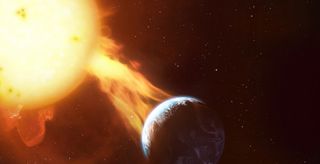
There are three different programs and scales about defining the range of environmental impacts they may have and their extent. In addition, each of the scales includes information about how each type of activity occurs on average and the type of power associated with each level.
For geomagnetic storms, numerical models focus on impacts to aviation, power grids and other Earth infrastructure.
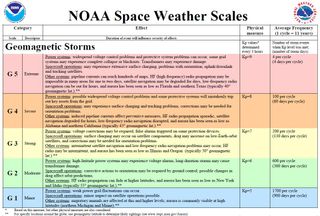
In the case of solar radiation, impacts include the biological effects of astronauts and passengers on board and how satellites and other systems may be affected.
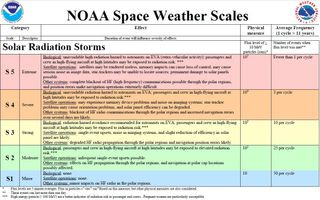
The third dimension, radio jamming, focuses on the effects space weather can have on high frequency (HF) radio and navigation systems.
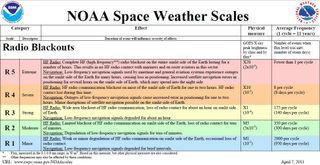
Murtagh explained that the scales are based on three main points of impact from solar radiation events.
“We discovered what we consider three main areas, three main sources of explosions in the Sun. The first is the solar flare, the products that come out of it, what we call the solar radio wave ( R).Soon after that, we’ve got our flow of strong, energetic protons, and that’s our S-scaled storm, the last one, the massive coronal extinction (CME). ,” Murtagh said.
“It goes to Earth, affects the magnetic field, and then we have a geomagnetic storm, and that would be G.”
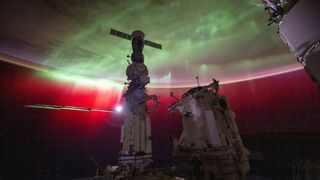
Since the scale was created, their user base has begun to expand from a knowledge-hungry public to a variety of industries that are more involved in how space climate can impact communities and consumers. they served.
For example, emergency response organizations such as Federal Emergency Management Agency (FEMA) began asking more questions from SWPC about whether and how radio blackouts could affect satellite and cell phone communications based on the issue of Radio Blackouts. Other examples include concerns about the different levels of “radiation” from solar storms that can appear.
“We have a scale called Solar Radiation, and level S4 is called high radiation. I got to tell the public that the environmental radiation will increase when they are in the air to the point that we’re going to call it a radiation storm; it’s causing great concern,” Murtagh said.
Even airlines told NOAA that they want to better understand what the scale means for their passengers.
“We had the captains here with us last year, and they all said, ‘You guys need to change that, right?’ We got severe turbulence, we had severe icing, and we know what that means, but the radiation is so severe people will get out of the plane because of radiation sickness, they will die just people don’t know it Another word we should be addressed is the work,” said Murtagh.
Astronauts are also interested in the new weather scales as many commercial companies rely on satellites for operations, said Kim Klockow McClain, senior scientist for the National Weather Service (NWS).
“Think about all the cubesat constellations; those are used as critical infrastructure in some places and are going to be the ones that provide the Internet in some developing countries. We are put most of the low orbit in some weak places. Some of these events don’t count directly on the scales like neutral density,” Klockow told Space.com. and in interviews.
“We need to think about the decisions that people make on the ground and go beyond just defining our risk to really try to communicate about the impact. This is a challenge that crosses all areas of risk, Klockow added.
NOAA is expected to complete its findings on the new climate satellites by the end of the year, and the information will be distributed across various government agencies including the White House, the Department of Energy, the Department of Transportation, and the Federal Aviation Administration. Administration. (FAA). The results will guide teams at NOAA and NWS in making decisions on what changes need to be made in the immediate and long term.
“We have to say, one option is this, I think this is what we need to do and maybe with this change, we can do it in six months. Two options, good idea, it will take three years and I recommend that we follow it, all those kinds of discussions will take place, I think we can make a change in the number of people who are useful in a few months in 2025, “said Murtagh .
“I think we can make a small but significant change on the scale. We can do a lot in a short time, but there will be a clear effort and a big effort in the next year and it’s more.”
#lot #changed #NOAA #rewriting #book #track #solar #storms